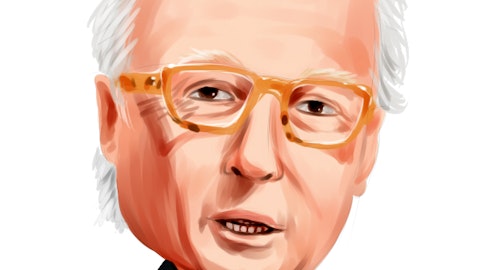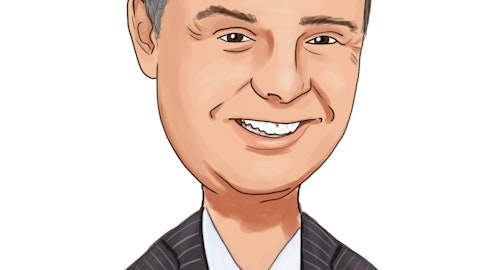Dave Bishop: Got it. And then, sticking with the liquidity position. I think you said there was maybe $300 million of excess liquidity in the quarter, where do you see that trending over the near term?
James Mabry: I would say over the near and intermediate term, that will trend down. Clearly, we wanted to keep some excess liquidity on the balance sheet at quarter end. But depending upon the environment and how things behave in the banking industry. I would suspect that gradually trends down over the course of the year.
Dave Bishop: Got it. And then just one housekeeping item. I thought I saw a tick up in 90 days past due. Curious if that was administrative paperwork type end of year, end of quarter delays in terms of financials or such. But looks like those ticked up to about $18.6 million from like $300,000, just any color there.
David Meredith: This is David. Jim mentioned in the opening comments, there were 2 credits that rolled into that 90-day past due bucket. Those are credits we had identified, and they were in our previous past due numbers. We had them as criticized assets. So we have noted there were loans on both of those, we feel very strongly that we’re in a great collateral position and anticipate no loss on those. So those rolled into our NPLs. We expect to work out of those normal course of business without any charge-offs.
Jim Mabry: As you’ll note, you can see the 30 to 89-day number, past due numbers actually bumped down a little bit from 51 to 43. We’ve seen were relatively flat in our criticized assets. They went down a few basis points quarter-over-quarter. So absent those couple of loans, our asset quality held pretty strong in the first quarter.
Operator: Our next question will come from Catherine Mealor with KBW. You may now go ahead.
Catherine Mealor: I wanted to ask about outlook for loan growth, just given the current environment. Are you seeing a pullback in production and pipeline? Or do you still think we can kind of keep a low to mid-single-digit kind of growth rate this year?
Mitch Waycaster: Yes. Catherine, the moderation that we’ve seen the last actually 2 quarters continued this quarter. We do feel very good about our ability to continue to produce. And just, I guess, to drill a little more there, the pipeline going into the quarter was $163 million that had moderated from $200 million in the prior quarter. But the good part is, like I say, we still feel good about production. We see that spread across the regions, the business lines, each continue to contribute in a meaningful way. And as I’ve mentioned in prior quarters, in addition to that geographic distribution is just our loan types and size of credits, the granularity in our loan book, Jim mentioned this in the opening comments, it looks a lot like our deposit side of the balance sheet.
And we’re very pleased with that. As I look at this quarter’s production of $415 million, about 36% of that production was still in that consumer 1 to 4 residential. And then, when you get into the small business and commercial, small business and business banking was about 13%, the commercial book, and that would be loans $2.5 million and greater owner-occupied C&I, and we’re seeing good production in C&I, very pleased with the Southeast business in Republic. Both of those partnerships coming from last year have been very productive, along with some of our other C&I lines as well as some of the CRE business, even though that’s pulled back some, certainly. But that represented another 24%. And then when you get into corporate banking, some larger C&I, commercial real estate type credits rounded out to 27%.
So you see, again, very granular and then distributed across a number of business lines. So we continue to hit on many different cylinders and produce, like, say, granular good core relationship-driven type loan growth, and we expect that to continue and relative to your question kind of where we see that coming in, I would expect Q2 to be somewhat reflective of Q1 relative to net. Catherine, and I’ll add another contributor to that net is payoffs as we’ve seen production moderate. So as well, we continue to see payoffs moderate as well, which contributes to the net result.
Catherine Mealor: Great. And then circling back, Jim, to the margin conversation. You gave your expectations for interest-bearing deposit costs. How are you thinking about the mix shift out of noninterest-bearing and where that may land as a percentage of deposits at the end of the year?
Jim Mabry: Good morning, Catherine. Well, of course, we don’t know the answer to that. But I would say this, that migration is going to continue. I think we peaked at roughly 35% or 36% NIB and we’re a quarter in here. I think we’re right around $31 million. I don’t know where it ends up at the end of the year, but a reasonable expectation would probably be something in the upper 20s.
Catherine Mealor: Great. And as we mix shift that you think more of the growth it flows into CDs? Or how do you think about the mix shift within the categories within deposits?
Jim Mabry: We would hope that what we can do is hold total deposits flat. So we’re hoping that NIB migration turns into, we get that to money markets or CDs.
Catherine Mealor: Great. Very helpful. All right. Thank you. Actually let me ask one more on the margin. So just big picture on the margin. I don’t think you gave, Jim, get your thoughts on just, how you’re margins still have to forecast. But maybe just for the next quarter, how you’re thinking about kind of what level of compression we could see again in the second quarter.





